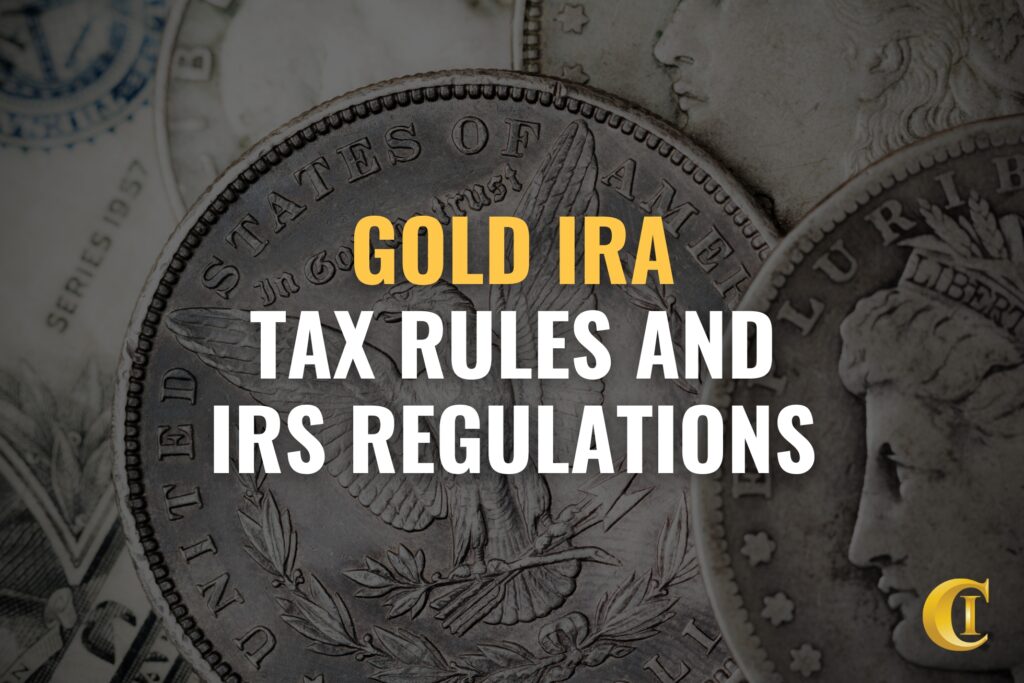Gold IRA Tax Rules and IRS Regulations
Learn the essential tax rules and IRS regulations for gold IRAs. In this article, you’ll learn how to stay compliant by following ontribution limits, storage, withdrawal rules, and more.

Written by Rick Erhart
Rick Erhart is an experienced precious metals professional with more than ten years in the field. He earned a degree in finance and is widely regarded as a specialist in self-directed IRAs.
A gold IRA (also called a precious metal IRA) is a form of self-directed IRA that lets you invest in physical gold while still enjoying the advantages of a conventional retirement account. Generally, the gold IRA rules and tax regulations are the same as those for a traditional IRA you might already have or know about.
However, a gold IRA includes extra regulations concerning gold storage and purity. This guide provides an overview of the essential rules for gold IRA contributions, storage, withdrawals, and more.
Overview of Gold IRA Tax Rules
An IRA enables you to save for retirement with unique tax advantages. Your investments can grow over time without incurring taxes on capital gains, as long as the funds remain in the account.
Gold IRAs are subject to taxation, and the specific type of IRA you select dictates how and when the IRS applies taxes to your account.
There are three main types of gold IRAs: Traditional IRA, Roth IRA, SEP IRA. You can convert Traditional, Roth and SEP IRAs into their respective gold-backed versions via a process called a gold IRA transfer or rollover. Each type follows distinct rules for contributions, withdrawals, and tax obligations.
Traditional Gold IRA
A Traditional IRA saves pre-tax money for retirement, taxed when you withdraw. A Traditional gold IRA is the same but holds gold, so you don’t pay taxes on that income upfront.
The funds grow tax-deferred, and you only pay taxes when you withdraw the money. If you wait until age 59½ or older, you can take withdrawals without facing early withdrawal penalties.
Gold Roth IRA
In a Roth IRA, you contribute after-tax dollars, so taxes are paid on the money before it enters the account. Your investments then grow tax-free, and qualified withdrawals are also tax-free, provided you meet certain requirements.
A Roth gold IRA holds gold but keeps the same tax-free benefits. Many financial advisors consider the Roth IRA one of the most effective retirement savings options.
SEP Gold IRA
A SEP (Simplified Employee Pension) IRA helps self-employed people and small business owners save for their own retirement and their employees’ future.
Employers put in pre-tax money, letting the account grow without taxes until withdrawal. You’ll pay taxes when you take money out (usually at 59½ or later) to avoid early withdrawal penalties.
A SEP gold IRA follows the same structure but invests in physical gold assets. Compared to Traditional or Roth IRAs, SEP IRAs offer higher contribution limits.
Precious Metal IRA Rules to Follow
To set up and manage a gold IRA per IRS rules, you must purchase IRS-approved gold, adhere to annual contribution limits, and ensure secure storage in a licensed depository.
1. Select IRS-Approved Gold Bars and Coins
The IRS sets strict standards for the quality, purity, and origin of gold bars and coins eligible for inclusion in an IRA. These requirements ensure only high-quality precious metals are used.
For gold coins to be IRA-eligible, they must be produced by a government mint and have a minimum purity of 99.5%. An exception to the purity rule is the American Gold Eagle coin. This is a 1-ounce coin primarily composed of gold, which is still approved despite not meeting the 99.5% purity threshold.
The coins also have to be uncirculated, and remain in pristine physical condition. For proof coins, they must remain in their original packaging and include a certificate of authenticity.
Popular and reputable precious metals IRA companies and gold dealers are familiar with these regulations and offer coins that comply with IRA standards.
Gold bars and rounds must also meet the 99.5% purity requirement and be produced by manufacturers, assayers, or refiners accredited by the Commodities Exchange (COMEX). Other recognized exchanges also qualify, as long as their gold bars and rounds meet the purity requirements.
2. Stay Within Contribution Limits
Gold IRAs operate under the same tax rules as standard IRAs, ensuring consistency across retirement accounts. You can fund a gold IRA through three primary methods:
- Rollovers
- Transfers
- Direct contributions
A rollover involves converting an eligible retirement plan, such as a 401(k), into a gold IRA. If you’re 59½ or older and have an existing IRA or 401(k), you can move those funds into a gold IRA without incurring taxes or penalties.

A gold IRA transfer allows you to shift funds from an existing IRA to a self-directed gold IRA, enabling you to hold physical gold. There are no age or employment restrictions for transfers. The assets move directly from one IRA to another, preserving your existing tax benefits. Since the funds are not withdrawn, transfers have no tax consequences.
Direct contributions involve adding cash to your gold IRA, subject to annual limits. Each IRA type permits direct contributions, but the limits and rules vary.
Beyond contribution caps, each IRA type has specific guidelines on tax deductibility and mandatory distributions. Below are the rules for the 2025 tax year:
| Type of IRA | Maximum Yearly Contribution Limit | Penalty-Free Withdrawals | Tax Deductible | Required Minimum Distributions | Are Withdrawals Taxed? |
|---|---|---|---|---|---|
| Traditional IRA | $7,000 (under 50) $8,000 (50 and up) | Age 59½ | Yes | Age 73 | Yes |
| Roth IRA | $7,000 (under 50) $8,000 (50 and up) | Age 59½ | No | No | No |
| SEP IRA | $70,000 (or 25% of income) | Age 59½ | Yes | Age 73 | Yes |
Since Roth IRAs are funded with after-tax dollars, contributions are not tax-deductible, but you’re also not required to take minimum distributions at any age.
Traditional and SEP IRAs, however, let you deduct contributions in the year you make them, but you’ll pay taxes on withdrawals as income.
3. Comply With Gold IRA Storage Requirements
The IRS not only regulates the types of precious metals eligible for a gold IRA but also enforces strict rules on where these assets must be stored.
According to IRS guidelines, gold IRA holders must keep their precious metals in a secure, independent, and insured storage facility. These depositories adhere to rigorous standards for record-keeping, reporting, safety measures, security protocols, and insurance coverage.
Several IRS-approved depositories operate across the United States, including:
- Delaware Depository
- Brink’s Global Services
- Texas Precious Metals Depository
- JPMorgan Chase Depository
- IDS (International Depository Services) Group
- HSBC Depository
Many investors opt for a depository near their location, as most facilities permit scheduled visits. You can arrange an appointment, have your metals presented for inspection, hold them, and then securely return them to the vault.
4. Learn About Gold IRA Withdrawal Regulations
Taking physical possession of your gold or selling it and receiving the proceeds is treated by the IRS as a withdrawal from your gold IRA. Similar to withdrawing funds from a standard IRA. Your IRA custodian will report the transaction to the IRS, and you may be responsible for applicable taxes and penalties.
The withdrawal rules for a gold IRA mirror those of a traditional or Roth IRA. For a traditional IRA, any funds you withdraw are subject to income tax. If you take money out before reaching age 59½, the IRS imposes an additional 10% penalty. Additionally, individuals aged 73 or older must take required minimum distributions (RMDs) annually, or face substantial penalties.
For a Roth IRA, you can withdraw your contributions at any time without tax consequences. However, withdrawing earnings before age 59½ may trigger a 10% penalty, unless specific exceptions apply.
Keep in mind: gold IRA losses cannot be claimed as deductions!
Gold IRA losses cannot be deducted because IRAs are designed as tax-advantaged accounts.
A Traditional IRA taxes gains only when you withdraw funds, while a Roth IRA offers tax-free qualified withdrawals. Likewise, neither account recognizes losses for tax purposes.
The IRS does not permit deductions for unrealized losses caused by market fluctuations, such as a drop in gold prices. Unlike taxable investment accounts (where capital losses can offset gains or income) transactions within an IRA occur in a tax-sheltered environment. This makes losses non-deductible.
In rare cases, if you completely close out all IRAs of the same type (e.g., all Traditional IRAs) and the total amount received is less than your after-tax contributions, you may be able to claim the loss as a miscellaneous itemized deduction.
This is subject to specific tax rules, such as the 2% adjusted gross income (AGI) threshold, depending on the tax year. Withdrawals from a gold IRA are taxed based on the fair market value of the assets at the time of distribution. Losses on these withdrawals, however, are typically not deductible.
For Roth IRAs, you can withdraw contributions tax-free, but any losses on those withdrawals cannot be claimed as deductions.
Conclusion
In summary, gold in an IRA is taxed the same as in Traditional or Roth IRA. This retirement account offers a unique way to diversify your retirement portfolio with physical gold. However, a gold-backed IRA comes with strict IRS rules.
Compliance is critical to preserving the tax advantages of your gold IRA. You’ll have to select the IRS-approved gold, adhere to contribution limits, storage requirements, and withdrawal regulations.
